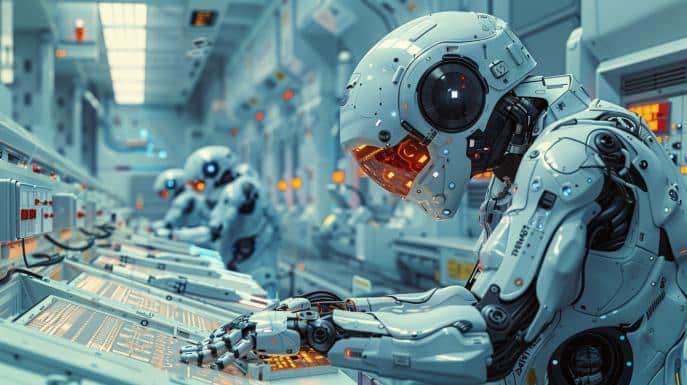Imagine a world where collaborative robots work side by side with humans in factories, robotic arms move with precision in assembly plants, and workplace safety reaches new heights with the help of advanced technology. This is the current panorama of several industries, transformed by robotics in everyday life. Efficiency and safety are just the beginning; Dive in with us in this read and discover how industrial automation is redefining the way we produce, operate and live. Get ready to experience the monumental impact of robots on manufacturing and beyond!
How are robotics affecting efficiency and safety in industries?
Robots in manufacturing are substantially increasing productivity and consistency. Especially with the incorporation of industrial automation, there is a notable leap in both efficiency and work safety. Using sophisticated systems such as robotic arms in assembly plants and collaborative robots, which operate side by side with humans, production quality intensifies. Furthermore, advanced robotics are reducing workplace risks by taking on dangerous and redundant tasks, which has a positive impact on workers' health.
Advances in safety are evident, as robotic technology allows operations that pose a high risk to humans to be performed with precision and without exposure to danger. For example, in the automobile industry, robots perform welding and painting, increasing the precision and efficiency of the vehicle assembly process.
The collaboration between humans and robots, known as cobots, stands out in several factory settings around the world. This synergy allows for safe interaction and increases human capacity, leading to a higher level of effectiveness on the factory floor.
What are the benefits of robotics in health and agriculture?
Robotics plays a revolutionary role in transforming surgical procedures and physical rehabilitation, enabling high-precision and minimally invasive surgeries, in addition to assisting in the recovery of patients through robotic exoskeletons. In agriculture, the use of robots contributes to precision cultivation techniques, optimizing production and monitoring plant health, promoting more efficient and sustainable agricultural practices.
Robotics in everyday life: how is it changing customer service and household chores?
– How are robots revolutionizing customer service in various industries?
Robots are transforming customer service through the provision of automated services, which includes chatbots on websites and robot assistants in physical stores, providing quick responses and 24/7 availability.
– How is the use of robots at home impacting daily life and environmental sustainability?
At home, collaborative robots like robotic vacuums and mops are saving people time and energy, while others, focused on quality inspection and maintenance, help extend the life of appliances, contributing to environmental sustainability.
What are the future predictions and challenges for robotics in our society?
Artificial Intelligence and autonomous robotic systems promise to reshape the future of cities and personal transport. Autonomous vehicles are planned to transform the urban landscape, promoting efficiency and reducing congestion. However, important ethical and professional challenges emerge with the expansion of robotics, including data privacy issues and unemployment risks due to automation. Robotics startups are at the forefront of innovation, expanding the applications of robotics across industries, from predictive maintenance to the development of assistive technologies. The increasing use of machine learning for training robots is also revolutionizing the way these machines learn and adapt to complex environments.
Throughout this article, we discuss how robotics is transforming various spheres, from manufacturing industries to unexpected fields like agriculture and healthcare. We have also seen that the integration of collaborative robots is improving workplace safety and boosting productivity. Robotics in everyday life promises to transform not only customer service, but also the management of domestic tasks, and entering the sphere of sustainability.
Looking to the future, AI and autonomous robotic systems promise equally fascinating innovations and challenges. We delve into the ethical implications and potential contributions of these technologies to society. It is clear that as we navigate these advancements, robotics will continue to be a dynamic and influential field, ceaselessly redefining the boundaries of the possible.
FAQ
Common questions
What are the main benefits that robotics offers for efficiency and safety in industries?
The main benefits of robotics for efficiency and safety in industries include substantially increasing productivity and consistency. Robotic technology reduces occupational risks by performing dangerous and redundant tasks, which results in greater health protection for workers.
How are robotics influencing healthcare and agriculture?
Robotics is revolutionizing healthcare by enabling high-precision and minimally invasive surgeries, as well as facilitating the rehabilitation of patients with robotic exoskeletons. In agriculture, it contributes to precision cultivation, optimizing plant production and monitoring, promoting more efficient and sustainable practices.
How are robots changing customer service and household chores?
Robots are revolutionizing customer service by providing automated services, such as chatbots and robot assistants, ensuring quick responses and constant availability. At home, collaborative robots save people time and energy and contribute to environmental sustainability, helping with the maintenance and useful life of devices.
What are the expectations and challenges for the future of robotics in society?
Expectations for the future of robotics in society include the reshaping of cities and personal transport with autonomous vehicles, promoting efficiency and reducing congestion. The challenges involve ethical and professional issues such as data privacy and unemployment risks. Innovation in robotics continues to advance in several sectors with the increasing use of AI and machine learning, which improve robots' learning and adaptation to complex environments.


